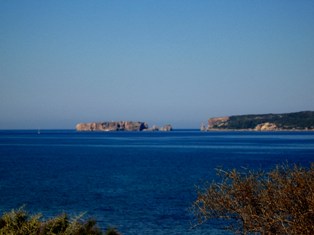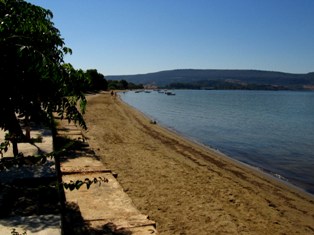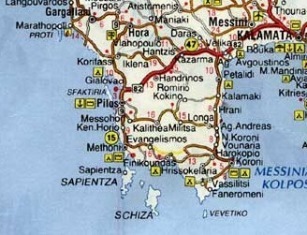
Arrive to the Pylos Greece
We arrive Pylos which is situated on the south west side of Peloponnese in the Prefecture of Messina. The town is some fifty kilometers far from Kalamata. The locals call the eastern entrance to the town Mytika. This is the point from where we enjoy the best view to the town of Pylos. The houses with their tile roofs seems to stretch down into the sea, the fortifications which seem to be trying to hold back the course of the time. On the horizon our eye catch the Fanari island with its characteristic "drill-hole" - the natural archway formed in its rocks.
We continue along the main street between the picturesque houses with their characteristic architecture and the even more characteristic bends in the road. We came to the main square of Pylos - Trion Navaron Square. All around are the ancient plane trees. The monumentin the centre of square commemorating the battle of Navarino.
 Walk through the old town of Pylos - Greece
Walk through the old town of Pylos - Greece
We reached in the heart of Pylos - so busy that we can almost hear its beat. It' s time now to plan our trip. Beaches the best of wich are well-kept secrets, which the initiated are reluctant to share. Historic monuments and museums, which tell the history of the region from ancient times up to the present day.Trips along the coast or into the interior - beckoming invitingly to the visitor. But most of all - the good life and a lively and colourfull crowd of local passers-by and visitors exploring the region.
You are now in centre of the Pylos town. Sunshine, the sea, hospitable pepole, a light breeze laden with history, blue skies, fruit bouquets , smiles, a friendly face: it is human. The aroma of oil and lemon wafts from the fish that bear witness to the generosity of the sea spread out before you. Here you know that catches are abundant and more than capableof pleasing your palate. And if meat is more to your liking, suckling pig raosted long and well in the oven before pleasantly losing itself in your stomach will tell youa heroic tale or two, from the time of the Ottoman occupation when these plump little creatures were a weapon in the hands of Messinians. They used them to startle the Ottoman cavalry, who eschewed pork, leaving it all for Greeks to eat. Hmm delicious taste the exquisite flavor of pre virgine olive oil, the staple of the local diet. Enjoy the characteristic aroma and low acidity of the oil of the region, made from Koroneiki olives which are sought by traders from other mediterranean markets like a "magic potion" to enhance their own produce.When the time comes to drink "to our health", we will clink glasses filled with the characteristic kight coloured wine, the nectar of many local varieties. the local salad, plants vegetables and, of course fruit are all flavoursome thanks to the soil and breeze in this area where a central friut and vegetable market is an alien concept. If you are lucky, your meal will end with "diples" as is customary at weddings.
 Ancient town of Pylos
Ancient town of Pylos
Ancient Pylos was situated north west of the city. It became significant during the Peloponnesian War. But it is not the same as King Nestors prehistoric city of Pylos which took part in the Troyan War, as reported by the historian Thucydides.
On the ancient acropolis there are remains of the Roman, early Christan and Hellenistic years, as well as tracesof the city fortifications. There are also ruins of a tomb wich according to the tradition, beloged to Thracimids, son of Nestor. From ancient building material of the 4th century BC the Franks built (1278) a large castle called Paleocastro in an area of the cape which closes the nort side of Navarinos gulf. Only the outside wall of the castle remains in a good condition. It is rectangular and encloses approximately 200m, while most of its square an dround towers are extant. However later alterations were made to the castle which altered its outward appeareance. Nearby lies the "cave of Nestoras". A legend says that Mercury hide the cows from Apollo in this cave while Pausanias reports that Nileas and the son of Nestoras used this cave as a stall.
 The castle of Pylos - Greece
The castle of Pylos - Greece
At the entrance of the anchorage of Pylos, there is Niocastro (in older times called Navarino), the newer castle of the city. It was built by the Turks (1573) in order to fortify the town after their defeat at Naupactos. It is one of the most well-preserved and charming castles of Greece. In 1829, it was repaired by Maison. Niocastro comprises a large enclosure with impressive ramparts, an hexagonal acropolis fortified with six bullwarks on the highest point, another one south-west and a Turkish aqueduct which supplied the castle with water. Inside the castle, there are the ruins of the Goth church of "Metamorphosis of Sotiras", built by the Franks, which was later turned into mosque by the Turks. Nowadays, it is church again.
On the way to Methoni, in the area of Kamares, the remains of an aqueduct were excavated. · Inside the anchorage of Navarino, there is the rocky Sfaktiria islet which attracts many visitors. You can get there by sailboat or small motor boat. On the islet there is a multitude of monuments of several ages. At the north end, on the hill of Prophet Elias, the remains of an ancient fortification wall commemorate a tragic event in the Peloponnesian War when 420 Spartans, encircled by the Athenians in BC 425, resisted for many days around two wells without drinkable water until those surviving were compelled to surrender. At the south of the islet there is the cenotaph of Tsamados, Anagnostaras and Sachinis, as well as the monument of Santarosa, the lover of the Greeks.
They were all killed during the battle of Sfaktiria in the period of the struggle of liberation from the Turks. On the islet there is also the grave of the Prince Paul-Maria Bonapart, nephew of Napoleon, who was killed on frigate "Hellas", near Spetzia, in 1827. At the north of the islet you will also see the grave of Megie, one of Maison’s French officers, who was killed in a sea battle off Navarino. In 1827, in the gulf of Navarino, occurred the famous historical sea battle of the same name, significant for the liberation of Greece. · The church of Panagia the "Sgrappa", at Eleophyto, 4km north of Pylos.
